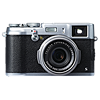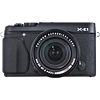Main
Model
Price
Advantages
launch
Announced
Body type
Camera subcategory
Sensor
Effective pixels
Max resolution
Sensor size
Sensor type
Processor
Image ratio w:h
Other resolutions
Image
ISO
Boosted ISO (maximum)
White balance presets
Custom white balance
Image stabilization
Uncompressed format
JPEG quality levels
Boosted ISO (minimum)
Photography features
Minimum shutter speed
Maximum shutter speed
Aperture priority
Shutter priority
Manual exposure mode
Built-in flash
Flash range
External flash
Flash modes
Continuous drive
Self-timer
Metering modes
Exposure compensation
AE Bracketing
WB Bracketing
Subject / scene modes
Screen / viewfinder
Articulated LCD
Screen size
Screen dots
Touch screen
Screen type
Live view
Viewfinder type
Viewfinder coverage
Viewfinder magnification
Viewfinder resolution
Videography features
Resolutions
File Format
Microphone
Speaker
Optics & Focus
Focal length (equiv.)
Optical zoom
Maximum aperture
Autofocus
Digital zoom
Manual focus
Normal focus range
Macro focus range
Number of focus points
Lens mount
Focal length multiplier
Physical
Weight (inc. batteries)
Dimensions
Environmentally sealed
Battery
Battery details
Battery Life (CIPA)
Storage
Storage types
Connectivity
USB
HDMI
Wireless
Remote control
Other features
Orientation sensor
Timelapse recording
GPS
Samples
Videos
Summary
The Fujifilm X100S has larger sensor compared to the X-E1: APS-C (23.6 x 15.8 mm) versus APS-C (23.6 x 15.6 mm). This is very important difference between these cameras because big sensor lets the photographer to shoot pictures of the more professional quality.
The X-E1 battery life is better than the Fujifilm X100S battery life. According to CIPA standards the camera owner will be able to take 350 photos with the X-E1 and only 330 with the X100S. The X-E1 weighs 350g that is 95g less than the weight of the X100S.
The X-E1 has 3 advantages and the Fujifilm X100S only 2 so the X-E1 becomes the best buy. Check the list of the best offers on Amazon.


